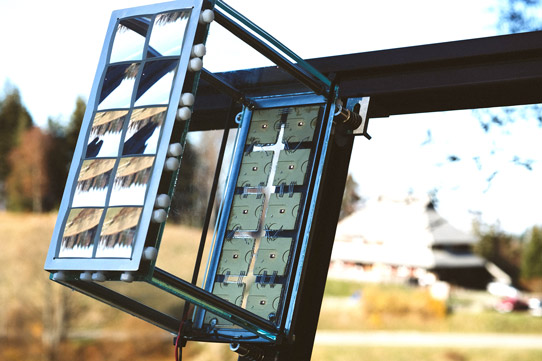- News
22 November 2018
Fraunhofer ISE-led CPVMatch project sets module efficiency record
© Semiconductor Today Magazine / Juno PublishiPicture: Disco’s DAL7440 KABRA laser saw.
In the €4.95m European Union (EU)-funded project CPVMatch (which lasted for 42-month, from May 2015 to October 2018), a consortium of nine research institutes and industry partners in Germany, Italy, Spain and France (coordinated by Fraunhofer Institute for Solar Energy Systems ISE in Freiburg) has achieved record solar energy conversion efficiency of 41.4% for a photovoltaic module. This was done by optimizing both the multi-junction solar cells as well as the interplay between the cell and the module optics to better exploit the potential of concentrator photovoltaic (CPV) technology.
High-concentration photovoltaic (HCPV) systems provide the highest solar energy conversion efficiency and thus correspondingly low use of resources, especially in regions with high direct normal irradiance. In HCPV modules, III-V compound semiconductor multi-junction solar cells comprise several thin subcells stacked on top of each other to convert the solar irradiance more efficiently. Optical lenses concentrate the incoming sunlight onto the miniature solar cells. The modules are mounted on a two-axis tracking system that follows the sun’s path during the day.
The CPVMatch project’s focus was industrial implementation of the highest-efficiency CPV modules and hence reducing the gap between research results and industry production.
“In CPVMatch, we have addressed all production steps for concentrator modules, starting from the materials, through cell fabrication and production systems, and up to the challenges facing module manufacturing,” says Dr Gerald Siefer, project head and group leader of III-V Cell and Module Characterization at Fraunhofer ISE.

Picture: HCPV module with record 41.4% efficiency.
The project partners have achieved two main results. By using innovative cell architectures for multi-junction solar cells with new materials, processes and manufacturing equipment, the researchers were able to optimize the production of four-junction solar cells. They were also able to improve the design of high-concentration modules, primarily by modifying the optics and making use of achromatic lenses. The combination of four-junction solar cells with achromatic lenses has led to the new record efficiency of 41.4% for a 122cm2 module.
The results “pave the way for further efficiency increases in the concentrator technology,” says Fraunhofer ISE director Dr Andreas Bett. “Photovoltaics is booming worldwide, and we see great potential for this particularly efficient module technology,” he adds. “It significantly decreases the use of resources for energy conversion per unit area and thus contributes to more sustainability.”
Fraunhofer ISE III-V multi-junction solar cells CPV


